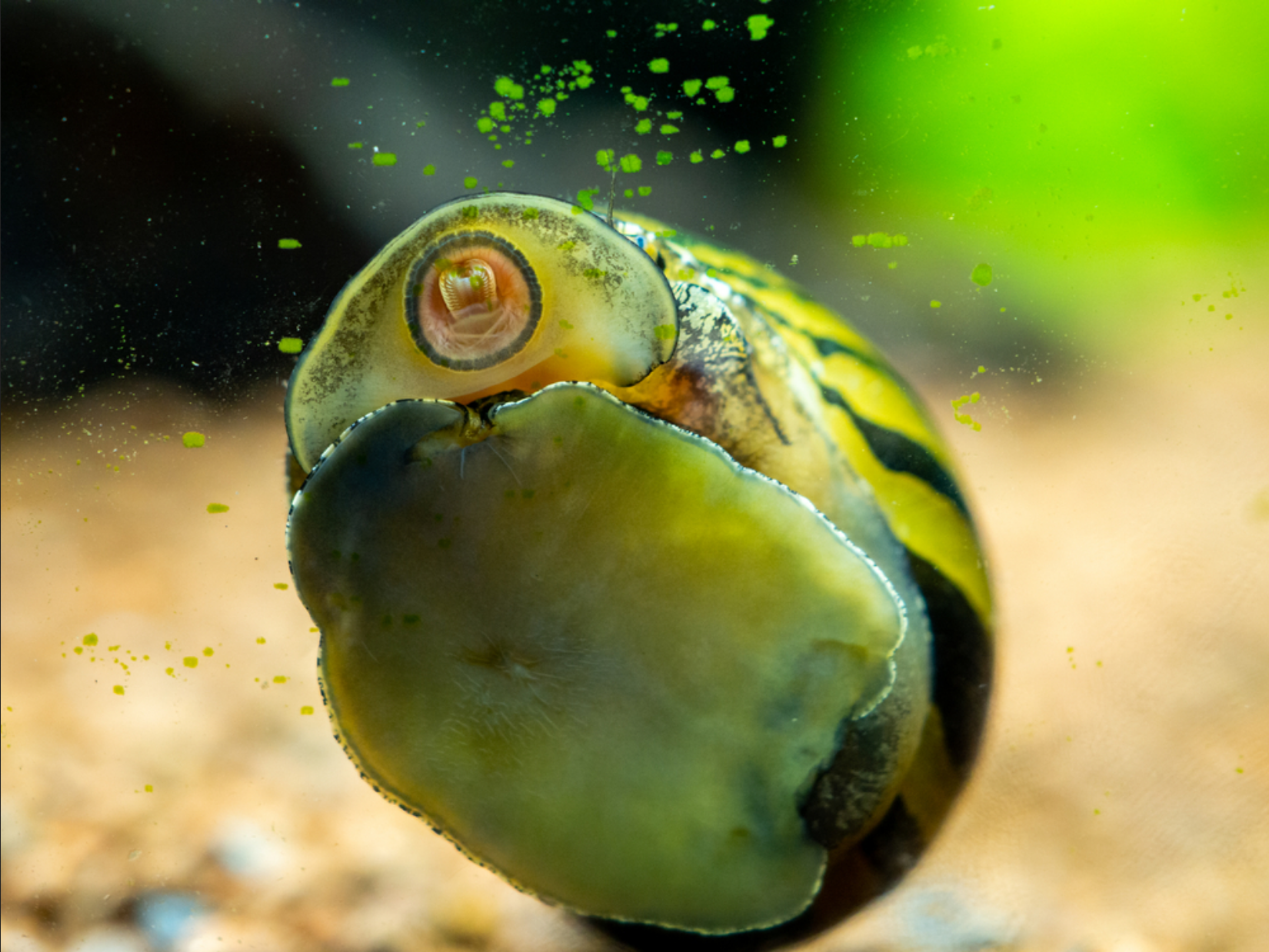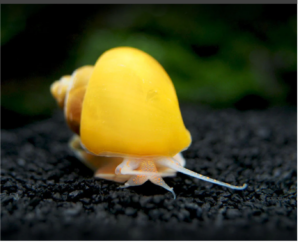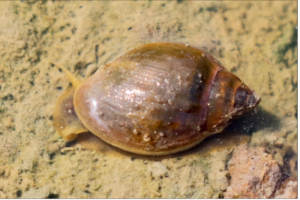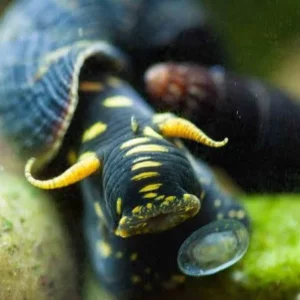In pet stores, you can find a variety of freshwater snail species, among them, Nerite snails. Nerite snails are an excellent choice for beginners and experienced aquarists. These peaceful snails are highly efficient and easy to maintain as tank cleaners.
Nerite snails are ideal for small tanks, reaching only an inch (2.5 cm) in diameter, making them suitable for 4-gallon (15 liters) setups. Their diet consists mainly of algae, decaying food, and fallen tank mates. Nerite snails can coexist harmoniously with non-aggressive fish and mollusks.
This comprehensive guide provides valuable tips on Nerite snail care, covering lifespan, tank setup, tank mates, feeding, breeding, and common diseases. It is a valuable resource for both beginners and those seeking to manage Nerite snail populations in their habitat.
Nerite Snail Origin and Habitat
Nerite snails belong to the taxonomic family Neritidae and the order Cycloneridita in the phylum Mollusca. They are small-sized freshwater and medium-water snails with gills and a distinctive operculum.
Originally native to Africa, specifically Kenya, Tanzania, and Mozambique, Nerite snails have expanded their habitats and can now be found along the Pacific and Atlantic coastlines. They are commonly found in delta areas, such as mangroves and estuaries, where freshwater sources merge with the ocean.
The Nerite snail is known for its adaptability to salty waters, easily migrating between salty and brackish water for feeding and breeding. This explains the presence of freshwater and saltwater Nerite snail species.
There are over 200 species of Nerite snails. In the wild, Nerite snails primarily inhabit salty water, occasionally venturing into murky brackish and freshwater environments for breeding.
They prefer brackish, slow-moving water since it provides optimal conditions for feeding, breeding, growth, and reproduction with minimal disturbance.
Nerite Snail Appearance and Size
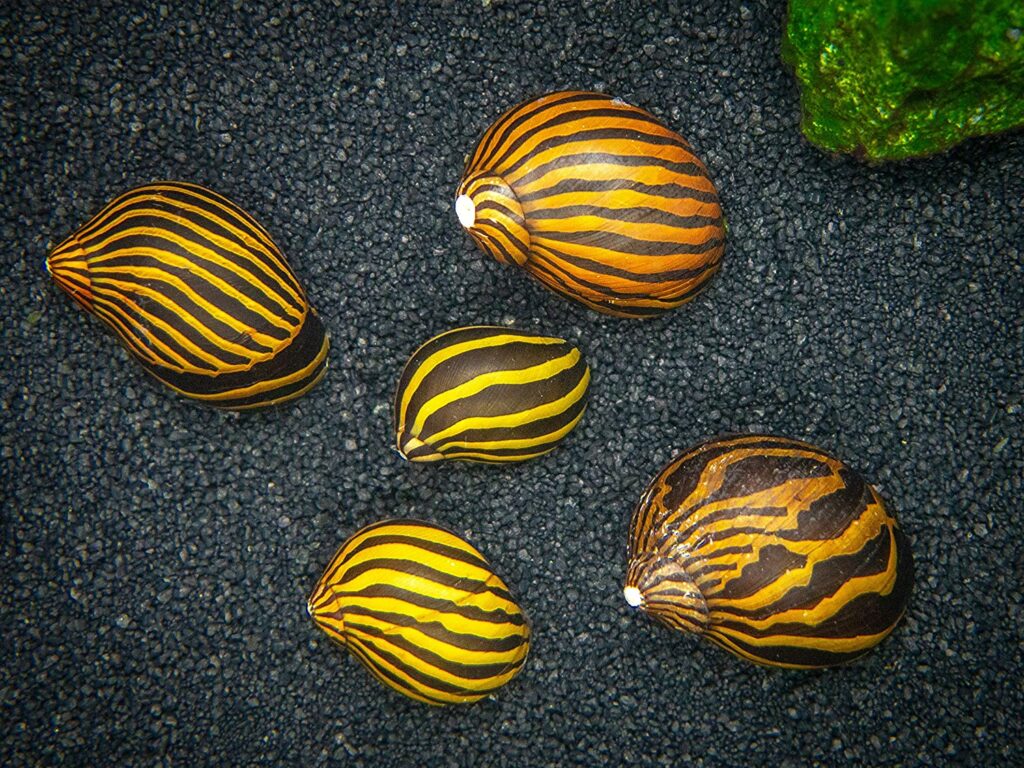
The Neritidae family consists of numerous species, each exhibiting unique appearances with various colors and shell designs.
Some Nerite snails have solid colors, while others are spotted or striped. There are also species with multicolored shells that are hard to count.
Additionally, certain species have distinctive horns. This diversity in appearance makes Nerite snails a wonderful addition to any aquarium, enhancing their color and overall beauty.
In terms of size, Nerite snails are generally small. The average recorded shell diameter for freshwater Nerites is approximately 1 inch (2.5 cm), with an average length of around 0.7 inches (1.8 cm).
With exceptional care, these snails may grow slightly larger, but there appears to be some genetic regulation of their size. Typically, Nerite snails reach their maximum size within about one year of age.
Common Freshwater Nerite Snail Species
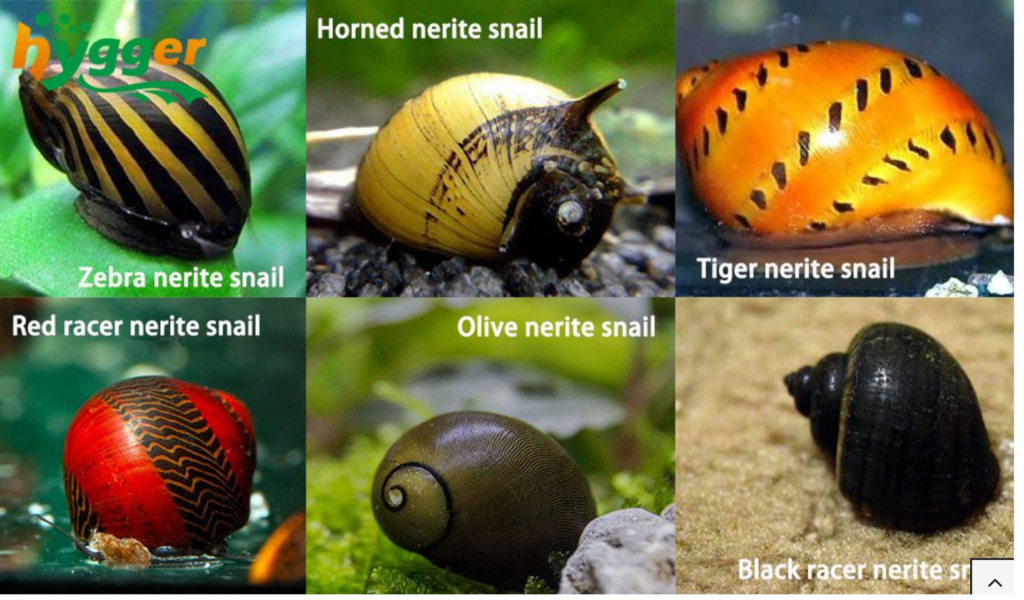
Pet stores offer more than 20 different Nerite snail species. However, it’s important to note that there can be variations in the naming of these snails, leading to different names in different locations.
Some popular freshwater Nerite snail species include the following. Links provided lead to Amazon and are examples and not endorsements of specific products.
- Tiger Nerite (Vittina turrita): This species features a shell adorned with light and dark stripes resembling a tiger’s skin pattern.
- Olive Nerite (Neritina reclivata): These freshwater snails have an olive color.
- Red Lip Nerite (Neripteron violaceum): This freshwater snail exhibits a multi-tone, dark marble shell with highly variable patterns.
- Horned Nerite Snail (Clithon CoronaCommon): These snails have shells with thick yellow and black stripes, but they are mainly recognized by the presence of dark horns.
- Black Racers (Neritina pulligera): Also known as the black military helmet or dusky Nerite, these snails have a fully dark brownish-grey coloration.
Buying Freshwater Nerite Snails

When purchasing Nerite snails from a pet store, it’s important to be vigilant for signs of health and quality. Look out for weak snails and empty shells.
A healthy Nerite snail will be active and firmly attached to a hard surface. If you come across a motionless snail lying upside down at the tank’s bottom, it is likely dying or already dead.
Additionally, inspect the snails for strong shells without cracks or gashes, and avoid buying empty Nerite snail shells.
It is advisable to choose smaller Nerite snails as they are younger and have longer lifespans.
You may find good deals on Nerite snails for sale at Aquatic Arts.
| Preview | Product | |
|---|---|---|

|
Aquatic Arts 5 Live Zebra Nerite Snails | Aquarium Substrate Clearer/Nano Tank Filter | Safe with… | Check Price |
Nerite Snail Lifespan
Similar to other freshwater snails, the average lifespan of a Nerite snail is around 2 years. However, with exceptional care provided by dedicated aquarists, some Nerite snails have been known to live up to 3 years.
Achieving this longer lifespan requires consistent optimal water parameters and appropriate feeding. On the other hand, with improper care, the lifespan of Nerite snails can be reduced to approximately 1 year.
Nerite Snail Tank Setup
The tank setup and diet are crucial aspects of Nerite snail care. One common mistake among Nerite handlers is overstocking the tank, assuming that these small snails, which do not reproduce in freshwater, can be kept in large numbers.
However, overstocking can lead to a high bioload and increased nitrogen levels, creating a toxic environment that can harm or wipe out the entire Nerite snail population.
Regarding bioload, read this interesting article exploring whether snails increase bioload.
For Nerite aquarists, I recommend a minimum tank size of 10 gallons, considering that people often keep a larger number of these snails. However, if you plan to keep them together with fish or other snail species, a larger 20-gallon tank is preferable.
The smaller 10-gallon (38 liters) tank has a few disadvantages, including a smaller surface area and lower water volume, which increases the risk of errors when adjusting water parameters.
Slight temperature, pH, and hardness changes pose a greater risk in smaller tanks.
I recommend the Aqueon 10-Gallon Glass Tank from Amazon. This Rectangular Standard tank is suitable for up to 5 snails. The tank is sturdy, clear, and affordable for beginners.
| Preview | Product | |
|---|---|---|

|
Aqueon Standard Glass 10 Gallon Rectangular Tank for Aquariums & Terrariums | Check Price |
The ideal water parameters for Nerite snails are as shown in the table below.
| Parameter | Range |
| pH | 6.5 – 8.5 |
| Temperature | 65°F – 85°F (18°C – 29°C) |
| Water Hardness (kH) | 12 – 18 |
Nerite snails are highly sensitive to copper, so it is crucial to treat tap water before adding it to the tank.
Also Read: Can You Use ParaGuard with Snails?
I recommend using the Poly Filter Poly-Bio-Marine for Fish Aquarium from Amazon. This filter effectively removes copper and other heavy metals from the water. It is affordable, easy to use, and suitable for fresh and saltwater environments.
| Preview | Product | |
|---|---|---|

|
Poly Filter Poly-Bio-Marine for Fish Aquarium – Works for Freshwater and Saltwater Fish Tanks -… | Check Price |
Consistency is crucial when maintaining optimal conditions for Nerite snails, requiring regular monitoring of the abovementioned water parameters.
I recommend using the SaySummer 7-Way Aquarium Test Strips from Amazon. This test kit accurately measures 7 parameters in both freshwater and saltwater environments. It is readily available on Amazon and in many pet shops at an affordable price.
| Preview | Product | |
|---|---|---|

|
7-Way Aquarium Test Strips, 100 Strips Aquarium Testing Kit for Freshwater Saltwater, Fish Tank Pond… | Check Price |
Nerite Snail Diet
Nerite snails are omnivorous creatures that feed on algae, leftover food, and deceased tank mates. They are efficient scavengers, consuming various types of algae when hungry and searching the tank bottom for remnants of fish food or deceased tank inhabitants.
While they may occasionally nibble on aquarium plants, they are not known to be significant plant eaters.
If you have multiple Nerite snails in your tank, it is recommended to supplement their diet with the following:
- Algae wafers
- Blanched vegetables such as kale, spinach, and carrots.
- Occasional calcium supplements should be added to the tank to promote healthy shell growth.
To replicate the natural habitat of Nerite snails, which is coastal estuaries, it is advisable to include a sufficient number of small to medium-sized rocks in the tank.
These rocks provide hiding places and a scavenging area for the snails, simulating their natural environment and promoting their well-being.
Nerite Snail Breeding
Nerite snail breeding presents two intriguing aspects:
- Firstly, these snails do not breed in freshwater.
- Secondly, Nerite snails are gonochoric, meaning they are either male or female, unlike hermaphroditic species that possess both male and female reproductive organs.
These characteristics add complexity to the breeding process of Nerite snails.
To breed Nerite snails in a regular freshwater tank, you must introduce salt to create a brackish environment and semi-salty water. However, caution must be exercised as other freshwater creatures may not survive in brackish water.
It is also crucial to use the appropriate amount of salt, as excessive salt levels can hinder the breeding process.
Related Reading: Can Snails Feel Pain?
I recommend using Instant Ocean Sea Salt for Marine Aquariums, which is affordable, acts quickly, and is free from nitrates and phosphates.
Introduce five or more Nerite snails into the tank to increase the likelihood of breeding. This enhances the chances of having both male and female snails present.
To determine the sex of a snail, you can observe the antenna of its right eye. If the antenna is tucked, it is a male snail; if it is straight, it is a female snail. However, this method may not work effectively for younger snails that are too small to be accurately observed.
Under suitable conditions, the snails will breed, and the female will lay eggs. These eggs will attach to glass or hard rock surfaces and hatch into shell-less larvae after a few days.
Within a week, these larvae will develop shells and can then be transferred to a freshwater habitat for further growth.
It is important to note that Nerite snails breed rapidly, and it is crucial to separate the males and females immediately after eggs are observed in the tank.
Nerite Snail Tank Mates
Nerite snails are generally peaceful and can coexist well with other invertebrates of similar temperament.
It is important to avoid aggressive fish as they may prey on small Nerite snails when hungry. Fish to avoid include:
- Aquarium crayfish
- Goldfish
- Betta fish
However, the main threat to the survival of Nerite snails is the assassin snail (Clea Helena), which will consume small Nerite snails whenever the opportunity arises.
Assassin snails have even been observed to form groups and target even the largest snails in aquariums. Small Nerite snails are particularly vulnerable to assassin snails.
Here are some suitable tank mates for Nerite snails:
- Trumpet Snails
- Ramshorn Snails
- Mystery Snails
- Ivory Snails
- Gold Inca Snails
- Bamboo Shrimp
- Vampire Shrimp
- Red Cherry Shrimp
- Ghost Shrimp
Final Thoughts
Nerite snails are becoming more popular in aquariums due to their low maintenance requirements. They come in various colors and shell designs, adding visual appeal to any tank.
One advantage of Nerite snails is that they do not reproduce in freshwater, so there is no need to worry about their population getting out of control.
Additionally, these snails are known for effectively cleaning the tank. Overall, Nerite snails are a great choice for aquarium enthusiasts.
Frequently Asked Questions
Can Nerite snails survive in salty water?
Most Nerite snail species can thrive in salty water. However, they require brackish water for reproduction.
Can Nerite snails live out of water?
Nerite snails are aquatic creatures and cannot survive entirely out of water. While they can stay out of water for up to 4 days, they ultimately need to return to the water to feed.
Do Nerite snails eat plants?
Nerite snails are not known to eat aquarium plants, although they may occasionally nibble on soft plant leaves. They primarily feed on fallen, unhealthy plant material on the tank floor and pose no threat to healthy tank plants.
How many Nerite snails per gallon?
The recommended minimum tank size for a single Nerite snail is 4 gallons (15 liters). As the tank size increases, you can add more snails. For a group of 5 Nerite snails, a minimum tank size of 10 gallons (38 liters) is recommended. If the tank is shared with fish, ensure that the tank size and stocking guidelines for fish are followed to prevent toxicity.
What are the common Nerite snail problems?
Nerite snails are generally hardy but sensitive to poor water quality and calcium deficiency. Poor water quality can lead to stunted growth and other health issues. Calcium deficiency may cause shell discoloration and cracking. Edema, which is excessive swelling of the snail’s body due to fluid imbalance, is a common disease in Nerite snails and is often associated with toxic tank water.
